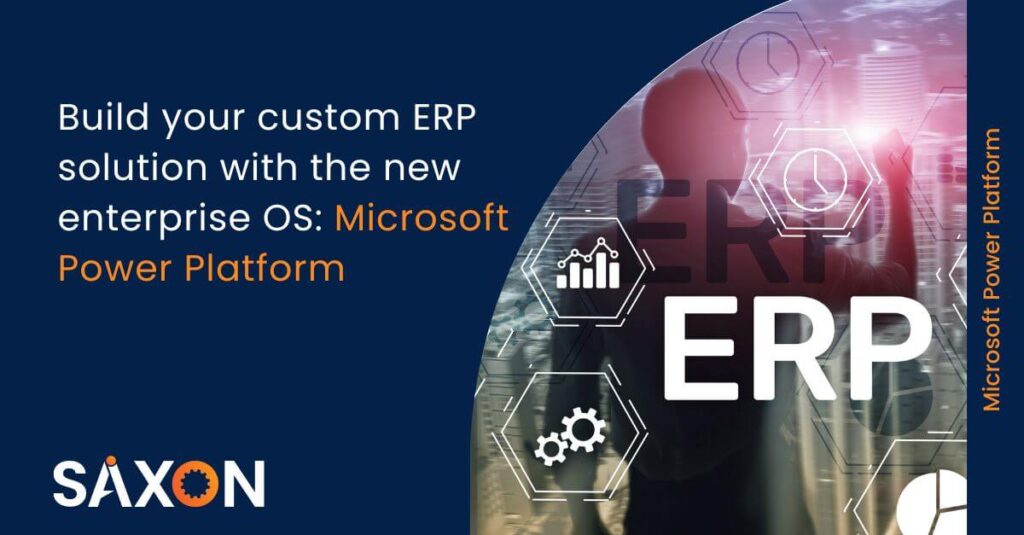As organizations grow and become more complex, they often need a more robust and integrated system to manage their operations. Custom enterprise Resource Planning (ERP) systems have long been the go-to solution for businesses to achieve this level of integration, but they can be costly and time-consuming to implement.
However, with the rise of low-code/no-code platforms, there is a new contender in town: Microsoft Power Platform. This platform offers a suite of powerful tools that can be used to create tailored solutions for various business needs. This blog post will explore how enterprises can turn to Microsoft Power Platform to build their custom ERP system.
What is an ERP system?
ERP, or Enterprise Resource Planning, is a software system that automates and manages key business processes for optimal performance. By integrating various departments and functions within an organization, ERP software provides a centralized platform for data flow, creating a single source of truth and streamlining operations across the enterprise. This comprehensive system connects financials, supply chains, operations, commerce, reporting, manufacturing, and human resources activities, enabling efficient collaboration and data-driven decision-making.
While many companies have separate systems for finance and operations, these siloed solutions are often limited in their capabilities and cannot effectively support future business growth. As organizations expand and evolve, their systems must keep pace with changing requirements. Implementing an ERP solution ensures businesses remain agile and efficient, adapting to new challenges and opportunities.
Why do you need a custom modern ERP system?
A custom ERP solution offers several advantages for businesses. Modern ERP systems come with built-in intelligence that guides users toward optimal outcomes, enhancing decision-making and productivity. Additionally, these systems have the scalability to accommodate business expansion into new markets while ensuring the security of client and company data.
Furthermore, a custom ERP platform offers cost-effective customization options, allowing businesses to tailor the system to their needs. This flexibility enables seamless integration with legacy systems and the extension of everyday processes as the organization grows.
The resource planning tools provided by a custom and modern ERP solution can significantly impact on various areas of business operations. It helps increase productivity, gain control over financial management, deliver superior customer service, streamline human resources management, optimize project management, enhance supply chain and operations management, and make informed decisions using business intelligence and AI capabilities. Thus, you can see the significance of having a custom and modern ERP system. It empowers businesses with adaptable and intelligent tools, enabling them to optimize their operations, meet specific business needs, and drive growth cost-effectively and efficiently. Let us now find out how to build it with the new enterprise OS, the Microsoft Power Platform.
How to build your custom ERP solution using Microsoft Power Platform?
Assess Your Needs
Before building your ERP solution using the Microsoft Power Platform, you must understand your business needs. Identify the core functions critical to your organization, such as finance, procurement, inventory management, and HR. Determine the workflows and data involved in each function and the data sources that must be integrated.
Identify Key Apps
Once you have identified your business needs, the next step is identifying the key applications you will need to build on the Power Platform. For example, you might need a finance app to manage invoices and payments, an inventory management app to track stock levels, and an HR app to manage employee data.
Build Apps on the Power Platform
With your needs and critical apps identified, it is time to start building your apps on the Power Platform. The platform includes several tools that can help you create custom solutions quickly and easily, such as Power Apps, Power BI, Power Automate, and Power Virtual Agents. For example, you can use Power Apps to create custom forms and dashboards that streamline your business processes. Power BI can create reports and visualizations that help you make informed decisions. You can use Power Automate to automate workflows between different systems and applications and Power Virtual Agents to create chatbots that can assist employees and customers.
Integrate Your Apps
Once you have built your apps on the Power Platform, the next step is integrating them with your existing systems and data sources. This can be done using connectors and APIs, which allow your apps to communicate with other systems and share data.
For example, you might integrate your finance app with your accounting system, inventory management app with your warehouse management system, and HR app with your employee database. This integration ensures that your apps are always up-to-date and working together seamlessly.
Monitor and Improve
Finally, monitoring and improving your ERP solution over time is essential. Use analytics tools such as Power BI to track performance metrics and identify areas for improvement. Continuously collect feedback from users and stakeholders to refine your apps and workflows.
By following these five steps, enterprises can turn Microsoft Power Platform into their ERP system. With its low-code/no-code tools, the Power Platform provides a flexible and cost-effective alternative to traditional ERP systems, enabling organizations to create custom solutions that meet their needs.
Take away
Microsoft Power Platform is set to be the new enterprise OS. With the underlayer of dataverse and the vast connectors, it adds flexibility and scalability to address organizational needs. With its low-code/no-code features, Microsoft Power Platform has made the process much more feasible and accessible and is reducing the overall cost of development and quick launch time. Following the five steps outlined here, enterprises can leverage the platform and create a flexible, cost-effective, custom ERP solution that meets their business needs.
Are you looking for a technology partner to support you in the process? Check out Saxon’s Power Platform consulting services. Our experts will walk you through the best plan and help you fetch the best ROI quickly.

